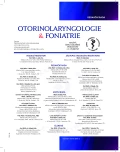Posterior Glottic Stenosis
Authors:
J. Schneiderová 1; Karol Zeleník 1,2; Pavel Komínek 1,2
Authors‘ workplace:
Klinika otorinolaryngologie a chirurgie hlavy a krku, Fakultní nemocnice Ostrava
1; Katedra kraniofaciálních oborů, Lékařská fakulta, Ostravská univerzita v Ostravě
2
Published in:
Otorinolaryngol Foniatr, 67, 2018, No. 2, pp. 67-70.
Category:
Case Reports
Overview
We present a case of a 75 - year old man with posterior glottic stenosis and difficult breathing. It is necessary to differentiate posterior glottic stenosis from bilateral vocal cord paralysis. Posterior glottic stenosis with arytenoid fixation is an uncommon complication of laryngeal injury. Through etiologies vary, the most common is prolonged intubation. Injury of posterior commissure may lead to scar and fixation of one or both arytenoid cartilages in an adducted position. Bilateral fixation commonly causes dyspnea, dysphonia and tracheostomy dependence. Surgical treatment techniques for posterior glottic stenosis includes simple scar transection, suture lateralization according to Ejnell or Lichtenberger, posterior cordectomy and subtotal or total arytenoidectomy and posterior cricoid split using cartilage graft (usually form rib).
Keywords:
dyspnea, posterior glottic stenosis, arytenoidectomy, suture lateralization by Ejnell method, cordotomy
Sources
1. Ejnell, H., Mansson, I., Hallén, O. et al.: A simple operation for bilateral vocal cord paralysis. Laryngoscope, 94, 1984, 7, s. 954-958.
2. Gallivan, G. J.: Bilateral vocal fold posterior glottic/subglottic stenotic web resected with contact tip Nd-YAG laser. Journal of Voice, 16, 2002, 3, s. 415-421.
3. Hatcher, J. L., Dao, A. M., Simpson, C. B.: Voice outcomes after endoscopic treatment of laryngotracheal stenosis. Annals of Otology, Rhinology and Laryngology, 124, 2015, 3, s. 235-239.
4. Hiller, A. T., Karatayli-Ozgursoy, S., Samad, I. et al.: Predictors of posterior glottic stenosis: a multi-institutional case-control study. Annals of Otology, Rhinology and Laryngology, 125, 2016, 3, s. 257-263.
5. Hoasjoe, K., Franclin, S., Aarstad, R. et al.: Posterior glottic stenosis mechanism and surgical management. Laryngoscope, 107, 1997, 5, s. 675-679.
6. Howard, N., Shiba, T., Pesce, J. et al.: Photodocumentation of the development of type I posterior glottic stenosis after intubation injury. Casereports in Surgery, 2015, s. 3.
7. Matsushima, K., Matsuura, K., Takeda, T. et al.: Transcricothyroid endoscopic subglottic surgery for posterior glottic stenosis: A case report. Journal of Voice, 31, 2017, 5, s. 634-637.
8. Rovo, L., Venczel, K., Torkos, A. et al.: Endoscopic arytenoid lateropexy for isolated posterior glottic stenosis. Laryngoscope, 118, 2008, 9, s. 1550-1555.
9. Sztano, B., Szakacs, L., Madani, S. et al.: Comparison of endoscopic techniques designed for posterior glottic stenosis – a cadaver morphometric study. Laryngoscope, 124, 2014, 4, s. 705-710.
Labels
Audiology Paediatric ENT ENT (Otorhinolaryngology)Article was published in
Otorhinolaryngology and Phoniatrics

2018 Issue 2
Most read in this issue
- Cysts Originating from Cervical Lymphatic Ducts
- The Closure of Nasal Septal Perforation by Custom Made Septal Obturators - First Experiences
- The Hypopharyngeal Reflux in Double-pH/Z Does Not Correlate with the Reflux Finding Score in Patients with Laryngopharyngeal Reflux
- Posterior Glottic Stenosis
